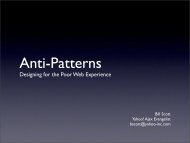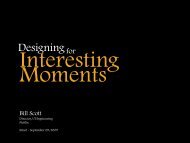Anti-Patterns - Bill Scott
Anti-Patterns - Bill Scott
Anti-Patterns - Bill Scott
- No tags were found...
Create successful ePaper yourself
Turn your PDF publications into a flip-book with our unique Google optimized e-Paper software.
<strong>Anti</strong>-<strong>Patterns</strong>Designing for the Poor Web Experience<strong>Bill</strong> <strong>Scott</strong>Yahoo! Ajax Evangelistbscott@yahoo-inc.com
ackground
ackground
anti-patternswhat are anti-patterns?“<strong>Anti</strong>-patterns, also called pitfalls, are classes of commonly-reinvented badsolutions to problems. They are studied as a category so they can be avoided inthe future, and so instances of them may be recognized when investigating nonworkingsystems. The term originates in computer science, apparently inspired bythe Gang of Four's book Design <strong>Patterns</strong>, which displayed examples of highqualityprogramming methods.” - Wikipedia, <strong>Anti</strong>-Pattern.interaction design anti-patternsLike the software anti-pattern counterparts, the following anti-patterns arecommon pitfalls to avoid.
anti-patternsbig ball of mud. meandering way.borg idiom. tiny targets. mystery meat.buried treasure. hover and cover.pogo stick navigation. novel notions.against the flow. metaphor mismatch.double duty. linkitus. blind type.windows aplenty. animation gone wild.misguided misdirections. unmarked hazards.missed moments. missing scene.one at a time. non-symmetrical actions.Note: anti-patterns denoted in bold are discussed in this talk.
anti-pattern. borg idiomsummaryNot all idioms play well together. Some idioms are more powerful than others.For example, tree controls, drag and drop, selection mechanisms all set up an“interaction theme”.Just like visual styles need to be consistent, interaction styles also need to beconsistent throughout the entirety of the interfaceBorg Idiom is the phenomonon of an idiom (once adopted) assimulating therest of the interface. Sometimes the assimulation is just the fact that one idiomdominates due to the way the interface clues the user to their presence.
anti-pattern. borg idiomOriginal design did not accurately reflect the hierarchical nature of projectscontaining documents.The tab idiom incorrectly communicated that these objects were in parallel.
anti-pattern. borg idiomAn initial redesign proposed using a tree control. It would communicate projectscontain documents. It would also become a navigation that would naturallyrepeat itself to the “gobbler” as wellTree controls are a “strong” idiom. They are not very friendly on the web. Theyrequire some dexterity to navigate. They play better on a desktop where“controls” are favored over “active content”.
anti-pattern. borg idiomThe final approach was to take a more content-driven approach rather than a“control-oriented” approach. This fit nicely with the rest of the interface, leavingall of the site to look like normal web pages.
anti-pattern. borg idiomThree idioms living in parallel with each other. The old style overwhelms theother two.
anti-pattern. borg idiomNetflix recently added drag/drop to their movie queue.Notice they were able to mix two idioms without one taking over from theother.Next step? drag drop delete?
anti-pattern. borg idiomTwo approaches. Object selection (highlight idiom). Item selection (checkboxidiom). Is it possible to marry the two?
anti-pattern. borg idiomCurrent Yahoo! Mail successfully married the two interaction idioms. It did it in away that you can use either idiom as both have their advantages.
anti-pattern. borg idiomHere was an early attempt on Yahoo! Bookmarks to blend drag and drop withitem selection (checkbox idiom). It has odd side effects during the interaction.In Yahoo! Photos (soon to close it’s doors) drag selection was implementedwell. One issue was the page metaphor + drag selection + a tray idiom.
strategies. borg idiomFor content-oriented rich sites, avoid becoming control-heavy. Stay away fromthe tree control and other strong desktop style controls. Make your contentinteractive, thus making the content the control.Before adding any interaction style, make sure it will scale across all know partsof your interface.Either allow yourself to be assimilated (be consistently borg :-) or eliminate theBorg from your site.Watch out when mixing drag and drop with checkbox style selection.Avoid mixing selection styles.
anti-pattern. meandering waysummaryNormal flow through the page takes the user on a meandering journey with themouse.alternate nameszig-zag interaction, scenic routeexampleActions hidden under hover (in context tools) that require the user to hover anarea, then move the mouse to an area that would normally be outside theobject’s space (back and forth operation)
anti-pattern. meandering wayIn our Y!Teachers product the first version of the hover caused a lot of mousezig-zagging to do common operations.
anti-pattern. meandering wayIn the redesign, we avoid any popup, any page jitter and make it possible to justmove the mouse to a predictable spot to do multiple operations.
anti-pattern. meandering wayIn previous company, I found this was a common occurrence in their suite ofsoftware application. By drawing red arrows indicating the user flow, it made theproblem obvious and helped to refactor to a correct solution..
strategies. meandering wayTake a snapshot. Draw red arrows through the interface for each user scenarios.Use this information to simplify flows and eliminate zig-zag interaction.During design refactoring, only display the elements needed for each interaction.This will allow you to focus on what is important for the interaction-- and what isactually the supporting information.Find the flow and layout consistent with that.Watch out for hovers. Make sure that all in-context tools that get revealedrequire no extra mouse move and are completely predicatable -- allowing theuser to gain speed in using the interface.
anti-pattern. tiny targetssummaryMaking key interaction points too small increases the likelihood that users willbe frustrated with the interface.fitts lawThe time to acquire a target is a function of the distance to and size of thetarget.examplesdivots for expand/collapse
anti-pattern. tiny targetsThe identity card area has a summary view and an expanded view.The targeting is really small and caused lots of usability issues.Several problems exist:The target for expand/collapse is hiddenThe area that reveals the target area for our identity card is only the photo and not the completesummary viewThe target is a very small divot that is hard to hit.
anti-pattern. tiny targetsThe target for opening the vocabulary list is actually anywhere in the completetitle. However, it looks like you can only click the little tiny divot (8x8 pixels)Redesign will call out “Close” as bigger target, but also cause title to have link.
anti-pattern. tiny targetsThe Yahoo! Gobbler has done well in tests due to the larger nature of the projectdrop targets.One issue that still needs to be addressed is the smaller target of the Text Dragbutton. Consistently causes problems-- too small.
anti-pattern. tiny targetsApple iphone keyboardiPhone has revolutionarydynamic target sizingapple web site has theplay controls as an8 x 8pixel target!
strategies. tiny targetsActivation targets and important commands need to be large enough, clearlyvisually distinct and in proximity to operation.Use in-context tools to support proximity.Use “Call to Action” style buttons for most important operations.If titles will expand/collapse, at least use hyperlink underline when hoverhappens to provide a bigger target.Never use 8x8 for targeting :-)
anti-pattern. hover & coversummaryHover reveal of information and actions has become more and more popular.Hover & Cover is when the hover actually hides important contextualinformation around the object or gets in the way of other actions.
anti-pattern. hover & coverOriginal hover was extremely annoying as itCovered the item to the right (natural flow is move to right)Occluded text edit area (hung open)
anti-pattern. hover & coverExample from plum.comDrop down menu shows on hover and gets in the way. Too easy to accidentallyturn it on.
anti-pattern. hover & coverYahoo! Local orginally had this hover beast.Thankfully it no longer functions this way :-)
anti-pattern. hover & coverThis one almosts leads to a new anti-pattern-- hover madnessSeriously what were they thinking?
strategies. hover & coverFor in-context tools, attempt to reserve same space for both hovered and nonhoveredstateFor hover details (information) place the hover in a manner that does not coverup important controls, will not cause accidentaly popup & down and is easy todeactivate.For hover details, allow a 1/4 second delaybefor activating.For in-context tools, show hover stateimmediately and provide consistenttargeting for operations from object toobject (allow user to get action itemjust in time)
anti-pattern. pogo stick navigationsummaryRequiring the user to go down a level or two, perform an operation, come backto the top and then have to go back down again. Name comes from hoppingup and down through the site.creditJared Spool
anti-pattern. pogo stick navigationNetflix faced the problem of users needing more information on a movie.They would go down to the details of the movie, possibly adding to the queue.Then they would go back to where they come from and repeat thisTheir solution involved an overlay that can support an alternate navigationstream. Then the user can come back to the main flow anytime they desire.
strategies. pogo stickDraw flow arrows between pages to catch the zig-zag bouncing from page topage (see Meandering Way anti-pattern).To avoid pogo effect:- Use incontext tools to bring actions into the current page- Use hover details to reveal information in context- Use overlays for encapsulating an alternate navigation path to allowtemporary exploration without losing the original context of navigation- All in page actions like inline editing, etc. to provide functionality inline.- Use incontext expands to reveal information on the page
anti-pattern. novel notionsummaryCreating a new interface for a common idiom that is more confusing than theoriginal. Sometimes it is just mis-using a component for a new purpose.examplesUsing drag and drop for simple attribute setting; using odd navigation schemesfor some supposed effect
anti-pattern. novel notionThis is just bizarre. Especially the “Search Jobs” link. And it plays music ;-)anti-pattern. name.
anti-pattern. novel notionThis guy won an award! Look it’s just marking stuff as ‘favorite’.Already solved.And this is yet another novel approach to favorites
anti-pattern. novel notionYahoo! Photos (going away) tried a novel approach to selection. It involved thenew concept of a “tray” for holding temporarily selected items.Technically perfect. But design-wise misguided. Created two targets forcommands: selected items and items in the tray.As a result the menu commands were duplicated for the tray and for thecurrent selection. Confusing.
strategies. novel notionUnderstand the purpose of each type of component- Carousels do not replace scrolled lists- Drag and drop is not for single attribute settingDon’t construct an artificial interface to support an idiom (don’t create thehouse for the nail)If you think you need something never created before, think twice about it
anti-pattern. metaphor mismatchsummaryWhen an idiom is employed that creates the wrong mental model for the user.
anti-pattern. metaphor mismatchFlickr allows you to have a temporary work area when organizing your photos.When removing items from this work area, you- drag and drop an item from work area back into your photo set- it shows a nuclear explosion when the item is put back into the set
anti-pattern. metaphor mismatchYahoo! TV. Redesigned the home page. What was the typical user’s mentalmodel for Y!TV? TV Listings.Where did my mental model go?
anti-pattern. metaphor mismatchyahoo underground gets it right with the carousel... timeline... starts at end
strategies. metaphor mismatchRealize that something as subtle as a title to an area, an icon (even usedtransiently) can mislead the user into thinking something else is happeningUnderstand the mental model you are constructing with each page. Ask yourselfabout how consistently you re-enforce that model by your interactions.
anti-pattern. double dutysummaryWhen a single interface element is called upon to perform multiple functionsexamplesExpand collapse header that also leads to details
anti-pattern. double dutyMost common example is when a header performs expand/collapse, but also isa link that leads to the item’s detail. Will clicking the project name take you tothe project page or expand/collapse the project area?
anti-pattern. double dutyHere in Google Maps, the search can take us to a location and bring in pizzalocations on the map. Dragging the map can take us to a location also. Whathappens when I drag? Will pizza locations update? The answer is no... but thisdoes cause confusion.
anti-pattern. linkitussummaryThe syndrome of having no idea where a link will lead you. could be an in pageaction, could reveal information, could take you to new page, could popupsomething, could engage on hover. Can also be aggravated by inconsistent useof links on the same page.examplesyahoo.com inconsistent use of links on main page, teachers.yahoo.com around idcard
anti-pattern. linkitusOn the home page, there are three kinds of links:- Reveal other content in context- Take you to the article- Expose area (hover to reveal, click to go to tool)
anti-pattern. linkitusBizarre use of links. Hover reveals information. Click does nothing.Very close to being a candidate for Novel Notions.
anti-pattern. windows aplentysummaryThe practice of throwing up unnecessary idiot boxes.So many reasons this is just wrong...
anti-pattern. animation gone wildsummaryAnimation effects that become the central focus instead of being part ofreinforcing a message.examplesamazon carousel, tab animation, (stuff from transition talk)
anti-pattern. animation gone wildWhy the extra little slide in?
anti-pattern. animation gone wildWow! What more can I say?Seems to be either a pixel at a time or going so fast you can’t use it
anti-pattern. animation gone wildMore from the gratuitous animation department...
anti-pattern. animation gone wildNot sure how much animation does for a tab control?Candidate for Novel Notions
anti-pattern. animation gone wild
anti-pattern. gratuitus animationanti-pattern. name.
anti-pattern. gratuitus animationanti-pattern. name.
strategy. animation gone wildTransitions mean something. They communicate.Understand the hierarchy of transition communicationRapid movementRapid color changeSlow movementSlow color changeIf you are refactoring a wild interface, simply turn off all animations and start bycommunicating fully without it, then add it back in.
anti-pattern. misguided misdirectionsummaryWhen you avert the user’s attention to the wrong thing due to some effect thatwas unitended (like page jitter; animation gone wild)
anti-pattern. misguided misdirection
anti-pattern. misguided misdirectionTwo versions of interactive Google. Second one does less mis-direction.
anti-pattern. misguided misdirectionOne hits you over the head; the other is nuanced.
anti-pattern. misguided misdirectionIn Y! Local, there is a two-step operation to open up information on the map.Hover activates the balloon.Click to get the detailsHowever, the hover brings up a popup which you expect to contain information. However, itcontains the message “Click icon for more info”.Here is what happensThe popup mis-directs you to what you think is information.You start to move the mouse to where it says “Click...”You realize that you have to find the iconThen you re-target the icon you were just hovering overAnd click to get the information.Compare this to Google MapsI just click.No hover to distract.You can actually do the same on both
anti-pattern. missed momentssummaryNot providing feedback throughout an interaction. These missed moments canconfuse the user about what to do.examplesDrag and drop is classic example.solutionsUse interesting moments grid to think through each moment
anti-pattern. missed moments
anti-pattern. missed momentsThis does not work because a number of interaction points miss providing cluesduring the adding stock symbols
anti-pattern. missed momentsUsing Y! Photos as example again. Notice missing feedback at key point piles onthe problems.
anti-pattern. missed momentsYou can also miss moments of creating interactive relationships of data. Theevent browser ties interactivity with information. Google maps search loses that.
anti-pattern. missed momentsLots of opportunities exist if you are careful to catch them
anti-pattern. missed momentsTurns out that a number of events exist during drag and drop that we can useto our advantage.
anti-pattern. one at a timesummaryWhen you can only update small pieces of the interface instead of doing thingsin a group.examplesbackpackit
anti-pattern. one at a timeKey is what is the workflow? One at a time or mutiple operations allowed.These kind of interfaces (in context tools) always present a problem for doingoperations on multiple items.
anti-pattern. one at a timeTakes one at a time check box to the extreme
anti-pattern. non-symmetrical actionssummarywhen what it takes to activate a window or function is really different that whatit takes to deactivate the window or undo the function.examplesamazon hover popupsolutions
anti-pattern. non-symmetrical actionsToo easy to popup... Too hard to get rid of.
anti-patternsbig ball of mud. meandering way.borg idiom. tiny targets. mystery meat.buried treasure. hover and cover.pogo stick navigation. novel notions.against the flow. metaphor mismatch.double duty. linkitus. blind type.windows aplenty. animation gone wild.misguided misdirections. unmarked hazards.missed moments. missing scene.one at a time. non-symmetrical actions.
my blog.this prez.looksgoodworkswell.combillwscott.com/share/presentations/2007/aesf/








